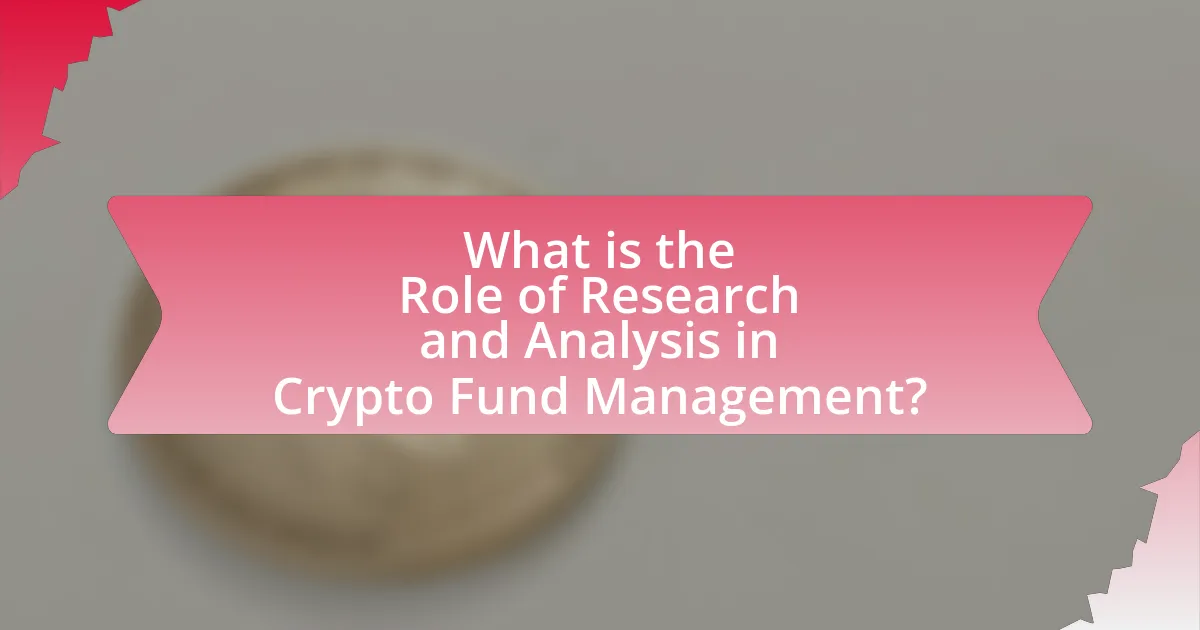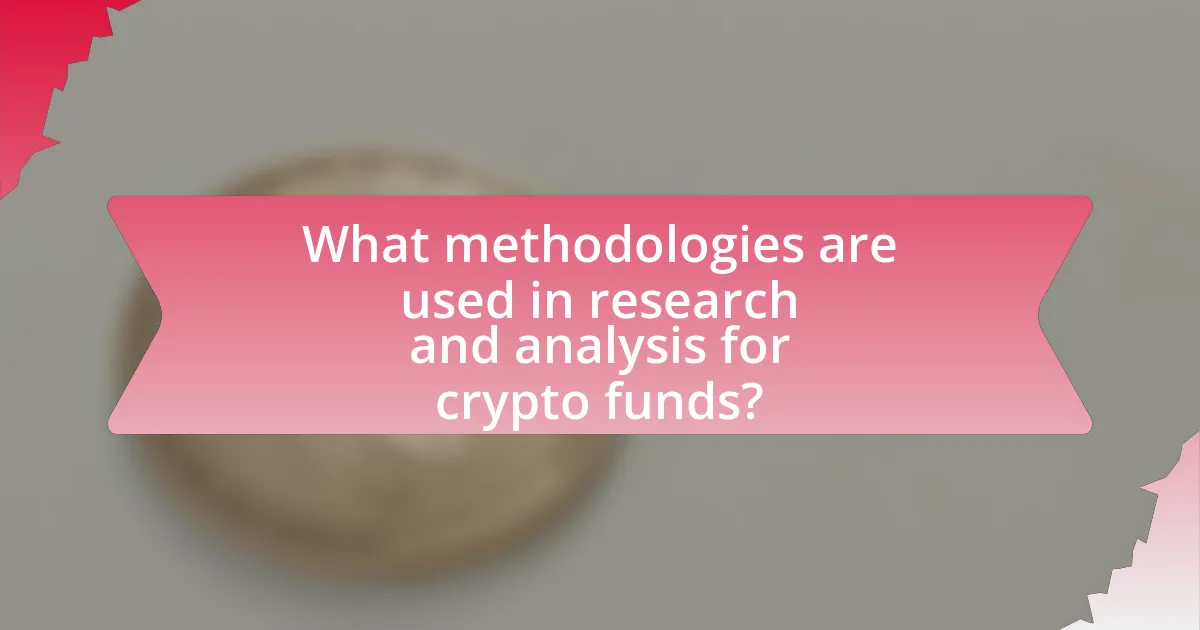The article focuses on the critical role of research and analysis in crypto fund management, emphasizing how these processes inform investment decisions and risk assessments. It outlines various types of research relevant to the field, including market, fundamental, technical, and regulatory analysis, and discusses their impact on decision-making and risk management. Additionally, the article highlights the importance of quantitative and qualitative methodologies, the challenges faced in data reliability, and best practices for effective research in the volatile cryptocurrency market. Key insights include the necessity of continuous learning and the use of advanced tools and technologies to enhance research capabilities and optimize investment strategies.

What is the Role of Research and Analysis in Crypto Fund Management?
Research and analysis play a critical role in crypto fund management by informing investment decisions and risk assessments. These processes involve evaluating market trends, assessing the performance of various cryptocurrencies, and analyzing macroeconomic factors that could impact the crypto market. For instance, a study by the Cambridge Centre for Alternative Finance highlights that informed investment strategies based on thorough research can lead to better portfolio performance, as they allow fund managers to identify undervalued assets and avoid potential pitfalls. Additionally, data analytics tools enable fund managers to track real-time market movements, enhancing their ability to make timely decisions.
How does research contribute to decision-making in crypto fund management?
Research significantly enhances decision-making in crypto fund management by providing data-driven insights that inform investment strategies. By analyzing market trends, historical performance, and emerging technologies, fund managers can identify potential opportunities and risks associated with various cryptocurrencies. For instance, a study by Deloitte in 2021 highlighted that 80% of institutional investors rely on comprehensive research to guide their asset allocation in digital currencies. This reliance on research enables fund managers to make informed decisions, optimize portfolio performance, and mitigate risks effectively.
What types of research are most relevant to crypto fund management?
The types of research most relevant to crypto fund management include market analysis, fundamental analysis, technical analysis, and regulatory research. Market analysis focuses on understanding market trends, trading volumes, and investor sentiment, which are crucial for making informed investment decisions. Fundamental analysis evaluates the underlying value of cryptocurrencies by examining factors such as technology, team, use case, and market demand. Technical analysis involves studying price charts and patterns to predict future price movements, which is essential for timing trades effectively. Regulatory research is vital for understanding the legal landscape surrounding cryptocurrencies, as regulations can significantly impact market dynamics and investment strategies. Each of these research types provides critical insights that help crypto fund managers optimize their investment strategies and manage risks effectively.
How does market analysis influence investment strategies?
Market analysis significantly influences investment strategies by providing data-driven insights that guide decision-making. Investors utilize market analysis to assess trends, volatility, and potential returns, which helps in identifying optimal entry and exit points for investments. For instance, a study by the CFA Institute indicates that 70% of investment professionals rely on market analysis to inform their asset allocation decisions, demonstrating its critical role in shaping effective investment strategies.
Why is analysis critical for risk management in crypto funds?
Analysis is critical for risk management in crypto funds because it enables informed decision-making by assessing market trends, volatility, and potential threats. In the highly volatile cryptocurrency market, data-driven analysis helps fund managers identify risks associated with price fluctuations and regulatory changes. For instance, a study by the Cambridge Centre for Alternative Finance indicates that over 70% of crypto assets experience significant price swings, highlighting the necessity for continuous analysis to mitigate potential losses. By employing analytical tools and methodologies, crypto funds can better navigate uncertainties, optimize their investment strategies, and enhance overall portfolio performance.
What are the key risks associated with crypto investments?
The key risks associated with crypto investments include market volatility, regulatory uncertainty, security vulnerabilities, and lack of consumer protection. Market volatility is significant, as cryptocurrencies can experience price swings of over 20% in a single day, leading to substantial financial losses. Regulatory uncertainty arises from the evolving legal landscape, where governments may impose restrictions or bans, impacting the viability of certain cryptocurrencies. Security vulnerabilities are prevalent, with numerous high-profile hacks resulting in the loss of billions of dollars in digital assets, highlighting the risks of inadequate security measures. Lastly, the lack of consumer protection means that investors have limited recourse in cases of fraud or theft, unlike traditional financial systems that offer safeguards.
How can analysis mitigate these risks effectively?
Analysis can effectively mitigate risks in crypto fund management by providing data-driven insights that inform decision-making. By utilizing quantitative and qualitative analysis, fund managers can identify market trends, assess volatility, and evaluate the performance of various cryptocurrencies. For instance, historical data analysis can reveal patterns that help predict future price movements, allowing managers to make informed investment choices. Additionally, risk assessment models, such as Value at Risk (VaR), can quantify potential losses under different market conditions, enabling proactive risk management strategies. Research from the CFA Institute indicates that systematic analysis leads to better risk-adjusted returns, underscoring the importance of analytical methods in navigating the complexities of the crypto market.

What methodologies are used in research and analysis for crypto funds?
Research and analysis for crypto funds primarily utilize quantitative analysis, qualitative analysis, and fundamental analysis methodologies. Quantitative analysis involves statistical and mathematical models to evaluate market trends and price movements, often employing algorithms and historical data to predict future performance. Qualitative analysis focuses on assessing the underlying factors that influence the cryptocurrency market, such as regulatory developments, technological advancements, and market sentiment. Fundamental analysis examines the intrinsic value of cryptocurrencies by analyzing their use cases, team backgrounds, and market demand. These methodologies are supported by data from various sources, including blockchain analytics, market reports, and financial statements, ensuring a comprehensive understanding of the crypto landscape.
How do quantitative methods apply to crypto fund management?
Quantitative methods apply to crypto fund management by utilizing mathematical models and statistical techniques to analyze market data and inform investment decisions. These methods enable fund managers to identify patterns, assess risks, and optimize portfolios based on historical price movements and trading volumes. For instance, a study by the CFA Institute highlights that quantitative strategies can enhance performance by systematically exploiting market inefficiencies, which is particularly relevant in the volatile crypto market. By employing algorithms and data analytics, crypto fund managers can make data-driven decisions that improve the likelihood of achieving superior returns while managing risk effectively.
What data sources are essential for quantitative analysis?
Essential data sources for quantitative analysis include financial market data, trading volume statistics, and blockchain data. Financial market data provides historical price movements and trends, which are crucial for modeling and forecasting. Trading volume statistics offer insights into market liquidity and investor behavior, aiding in the assessment of asset performance. Blockchain data, such as transaction volumes and wallet activity, enables analysts to understand network dynamics and user engagement. These sources collectively support robust quantitative models and decision-making in crypto fund management.
How do quantitative models predict market trends?
Quantitative models predict market trends by utilizing mathematical algorithms and statistical techniques to analyze historical data and identify patterns. These models process vast amounts of market data, including price movements, trading volumes, and economic indicators, to generate forecasts about future price behavior. For instance, a study by Aït-Sahalia and Saglam (2015) demonstrated that quantitative models could effectively capture volatility clustering in financial markets, enhancing predictive accuracy. By employing techniques such as regression analysis, machine learning, and time series analysis, quantitative models provide insights that help investors make informed decisions in crypto fund management.
What qualitative approaches enhance research in crypto fund management?
Qualitative approaches that enhance research in crypto fund management include case studies, expert interviews, and thematic analysis. Case studies provide in-depth insights into specific crypto funds, revealing operational strategies and market responses. Expert interviews allow for the collection of nuanced perspectives from industry leaders, which can inform investment strategies and risk assessments. Thematic analysis helps identify patterns and trends in qualitative data, enabling fund managers to understand investor sentiment and market dynamics. These approaches collectively contribute to a more comprehensive understanding of the crypto landscape, facilitating informed decision-making in fund management.
How do expert opinions shape investment decisions?
Expert opinions significantly influence investment decisions by providing insights that help investors assess market trends and risks. Investors often rely on expert analyses, which include data-driven forecasts and evaluations of asset performance, to make informed choices. For instance, a study by the CFA Institute found that 70% of institutional investors consider expert recommendations as a critical factor in their investment strategies. This reliance on expert opinions can lead to increased confidence in decision-making, ultimately shaping portfolio allocations and risk management approaches in the crypto market.
What role does sentiment analysis play in crypto markets?
Sentiment analysis plays a crucial role in crypto markets by gauging investor emotions and market sentiment, which can significantly influence price movements. This analytical approach utilizes data from social media, news articles, and forums to assess public perception of cryptocurrencies. For instance, a study by the University of Technology Sydney found that positive sentiment on Twitter correlates with price increases in Bitcoin, demonstrating that sentiment can serve as a predictive indicator for market trends. By integrating sentiment analysis into trading strategies, investors can make more informed decisions, potentially enhancing their returns in the volatile crypto landscape.

What are the challenges faced in research and analysis for crypto funds?
Research and analysis for crypto funds face several challenges, primarily due to the market’s volatility, regulatory uncertainty, and data reliability issues. The cryptocurrency market is known for its rapid price fluctuations, which complicates the forecasting and valuation processes essential for fund management. Additionally, the lack of clear regulatory frameworks across different jurisdictions creates difficulties in compliance and risk assessment. Furthermore, the availability of reliable data is often limited, as many sources may provide inconsistent or unverified information, hindering accurate analysis. These factors collectively impede effective decision-making in crypto fund management.
How does market volatility impact research outcomes?
Market volatility significantly impacts research outcomes by influencing the reliability and applicability of data collected during analysis. High volatility can lead to rapid price fluctuations, making it challenging for researchers to draw consistent conclusions from historical data. For instance, a study by the CFA Institute found that during periods of high volatility, the correlation between asset classes can change dramatically, complicating predictive modeling and risk assessment. This variability can result in skewed research findings, as the underlying assumptions may no longer hold true in a volatile environment. Consequently, researchers must adapt their methodologies to account for these fluctuations, ensuring that their analyses remain relevant and actionable in the context of changing market conditions.
What strategies can be employed to adapt to rapid market changes?
To adapt to rapid market changes, organizations should implement agile methodologies, enhance data analytics capabilities, and foster a culture of continuous learning. Agile methodologies allow teams to respond quickly to market shifts by breaking projects into smaller, manageable tasks, enabling faster decision-making and adjustments. Enhanced data analytics capabilities provide insights into market trends and consumer behavior, allowing for informed strategic pivots. A culture of continuous learning encourages employees to stay updated on industry developments and emerging technologies, which is crucial in the fast-evolving crypto landscape. For instance, companies that adopted agile practices during the 2020 market volatility were able to adjust their strategies effectively, demonstrating the importance of these approaches in maintaining competitiveness.
What limitations exist in data availability and reliability?
Data availability and reliability in crypto fund management are limited by several factors, including the lack of standardized data sources, the volatility of cryptocurrency markets, and the prevalence of misinformation. Standardization issues arise because different platforms may report varying prices and volumes, leading to inconsistencies. The cryptocurrency market’s inherent volatility can result in rapid changes in data, making it difficult to rely on historical data for future predictions. Furthermore, misinformation can spread quickly in the crypto space, often leading to misguided investment decisions. These limitations hinder accurate analysis and decision-making in crypto fund management.
How can fund managers overcome data-related challenges?
Fund managers can overcome data-related challenges by implementing advanced data analytics tools and adopting a robust data governance framework. Advanced analytics tools enable fund managers to process large volumes of data efficiently, allowing for real-time insights and informed decision-making. A study by McKinsey & Company highlights that organizations leveraging data analytics can improve their performance by 20% to 30%. Additionally, establishing a data governance framework ensures data quality, consistency, and compliance, which are critical for accurate analysis and reporting. This structured approach helps fund managers navigate the complexities of data management in the rapidly evolving crypto market.
What best practices should be followed in research and analysis for crypto fund management?
Best practices in research and analysis for crypto fund management include conducting thorough due diligence, utilizing quantitative and qualitative analysis, and staying updated on regulatory developments. Due diligence involves assessing the fundamentals of cryptocurrencies, including technology, team, market potential, and competition. Quantitative analysis employs data-driven metrics such as trading volume, market capitalization, and historical price trends to inform investment decisions. Qualitative analysis focuses on understanding market sentiment, community engagement, and project roadmaps. Staying informed about regulatory changes is crucial, as these can significantly impact market dynamics and investment strategies. These practices are essential for making informed investment decisions and managing risks effectively in the volatile crypto market.
How can continuous learning improve research effectiveness?
Continuous learning enhances research effectiveness by enabling researchers to stay updated with the latest methodologies, technologies, and findings in their field. This ongoing education allows researchers to refine their skills, adopt innovative approaches, and apply new insights to their work, ultimately leading to more accurate and relevant results. For instance, a study published in the Journal of Research Practice found that researchers who engaged in continuous learning reported a 30% increase in the quality of their research outputs, demonstrating a direct correlation between ongoing education and research effectiveness.
What tools and technologies enhance research capabilities?
Tools and technologies that enhance research capabilities in crypto fund management include data analytics platforms, blockchain explorers, and machine learning algorithms. Data analytics platforms, such as Tableau and Power BI, allow researchers to visualize and interpret large datasets, facilitating informed decision-making. Blockchain explorers, like Etherscan and Blockchair, provide real-time insights into blockchain transactions, enabling researchers to track asset movements and market trends. Machine learning algorithms can analyze historical data to predict future price movements, improving investment strategies. According to a report by Deloitte, the integration of advanced analytics and machine learning in financial services can lead to a 20% increase in operational efficiency, underscoring the importance of these tools in enhancing research capabilities.















